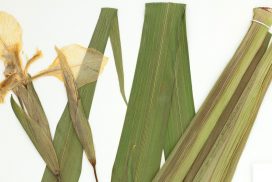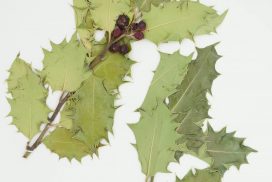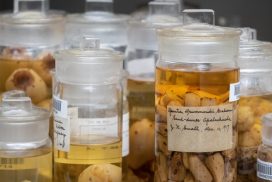Current Expeditions

MEGADIVERSE: THE FLORA AND MYCOTA OF VENEZUELA (PART 1)
Travel with us to a megadiverse country, Venezuela!
In your transcriptions, you may come across some fascinating genera of plants including Espeletia and Coespeletia, as seen on the expedition home page. These plants have leaves covered in dense, fuzzy hairs that make you feel like you’ve entered WhoVille. Part of the Asteraceae family, this genus occurs mainly in Venezuela, Colombia, and Ecuador, in a rare habitat called a páramo.
These habitats are facing increasing threats from climate change and anthropogenic developments. By transcribing specimens, you are helping the scientific community to better understand the flora of Venezuela, and helping make data available that can aid conservation.
MEGADIVERSE: THE FLORA OF INDONESIA (PART 4)
Indonesia is one of the world’s most biodiverse nations, with up to 5000+ plant species per 10,000 km2 (compared to 3000 plant species per 10,000 km2 in the U.S.). Situated within the Malesian floristic regions, Indonesia is a megadiverse botanical crossroad, linking the floras of India, Southeast Asia, and Australia. Ecosystems range from mangroves along the coast to the alpine slopes of the highest mountains, with high rates of endemism. As in many tropical regions, the biodiversity of Indonesia faces threats from development, mining, logging, and palm oil plantations, yet new species continue to be described from the region. Herbarium specimen digitization aids research to describe new species and construct conservation strategies to protect what remains.
This project is supported by NSF award 2100755.


PLANTS AND FUNGI OF THE NEW YORK CITY AREA (PART 1)
Embark on a botanical journey through NYC! The NYBG Steere Herbarium boasts over 40,000 specimens from NYC’s five boroughs, offering a glimpse into the biodiversity and cultural evolution of New York and surrounding areas. As urban areas become more densely populated, previously wild spaces that served as crucial habitats are lost to human development. However, green spaces still exist in NYC and provide significant biological value and diversity. The herbarium specimens in this expedition include important plants of both cultivated and wild origin, offering valuable data for further research and discovery. By transcribing collection data from these recent and historical specimens, you can provide essential information to better understand the flora of New York.

TERRIFIC PTERIDOPHYTES! FERNS OF SOUTH AMERICA (PART 1)
Pteridophytes are one of the oldest plant groups on Earth, with a fossil record dating back 420 million years! They range in size from towering tree ferns with trunks 20 m tall to floating ferns with leaves only 1 mm long. To reproduce, they release tiny, dust-like spores and therefore lack flowers, fruits, and seeds. Favoring warm, damp habitats, ferns are abundant in tropical South America.
NYBG’s Herbarium houses one of the world’s largest preserved fern collections and almost certainly includes some species not yet formally named and described. Help us transcribe specimen labels and contribute to pteridophyte research and conservation.
Funding provided by NSF award 1802305.
NYBG GLOBE SPOTTER
Every year, tens of thousands of new botanical collections make their way into the William and Lynda Steere Herbarium from every corner of the globe. When made accessible quickly to researchers online these incoming collections represent a vital flow of new information about the state of the world’s plants and fungi. Travel virtually to countries around world and help rapidly connect scientists to these biodiversity specimens by classifying their geographic origin.
GESUNDHEIT! THE SPICY WORLD OF THE PIPERACEAE
The Piperaceae–which includes the black pepper spice on your dinner table–are a large plant family spread across the tropical regions of the world. Ranging from trees to minute herbs, more than 2000 species of true peppers are known, and more are described every year. The propensity to sneeze when using black pepper is caused by the naturally occurring chemical Piperine, which is released from their dried fruits and can irritate the nostrils. Piperine may also have medicinal effects, as Piperaceae are often used in traditional medicines. By digitizing specimens of Piperaceae, you are helping NYBG botanists study and preserve this important plant family.
TERRIFIC PTERIDOPHYTES! FERNS OF MEXICO
Pteridophytes (including ferns and lycophytes) are one of the oldest groups of plants on Earth, with a fossil record dating back 420 million years. Unlike seed plants, they reproduce by releasing tiny, dust-like spores, so they completely lack flowers, fruits, and seeds. Of the nearly 11,000 species of ferns in the world, about one-tenth occur in Mexico, including tree ferns with trunks 15 m tall and floating ferns with leaves only 1 mm long. Now you can join NYBG’s latest virtual expedition to help scientists transcribe pteridophyte specimens from Mexico and contribute to continued research and conservation of these amazing plants.
THE ORCHID NEXT DOOR: ORCHIDS OF THE UNITED STATES AND CANADA
Most people associate orchids with faraway places like the Amazon Rainforest or the Himalayan Mountains. Although these locations do indeed hold diverse orchid floras, the U.S. & Canada host many beautiful species, from the wetlands of Southern Florida and the deserts of Arizona, to the Article Circle, and even in New York City. By digitizing orchid specimens held in NYBG’s William and Lynda Steere Herbarium, you can help scientists gather data needed to understand how orchids diversified across North America, while developing tools for conserving our native orchids in the future.
TROPICAL INVESTIGATIONS: PALMS OF THE WORLD
The palm family is a large and diverse group of flowering plants made up of approximately 2,400 species. These iconic organisms are distributed throughout tropical and subtropical areas of the world and have enormous economic importance. The New York Botanical Garden herbarium has one of the largest collections of palm specimens in the world, however many of these records have not been fully digitized. You can help researchers study tropical biodiversity by documenting NYBG’s palms!
TERRIFIC PTERIDOPHYTES! FERNS OF CENTRAL AMERICA (II)
Pteridophytes, otherwise known as ferns, are one of the oldest groups of plants on Earth, with a fossil record dating back 420 million years. They reproduce by releasing tiny, dust-like spores, so they completely lack flowers, fruits, and seeds. Favoring warm and damp habitats, pteridophytes are abundant in tropical areas like those in Central America where one-tenth of all ±11,000 fern species grow. They range in size from towering tree ferns with trunks 20 m tall to floating ferns with leaves only 1 mm long. Help us transcribe these herbarium specimen labels from Central America and contribute to pteridophyte research and conservation.
AMAZING ORCHIDS OF SOUTH AMERICA
Orchids are one of the most species-rich plant families in South America, ranging from the coast of Brazil to the high Andes, and from the Caribbean Sea to the tip of Tierra del Fuego. From the gaudy flowers of Cattleya and the large climbing vines of Vanilla, to tiny Pleurothallid orchids such as Dracula and Lepanthes that are pollinated by fruit flies, orchids are found in every environment across South America. In many habitats, orchids predominate as epiphytes that live harmlessly on the branches of trees with their roots exposed to the air. Orchids are especially common in the Cloud Forests of the high Andes, where they compose a large percentage of the overall plant species diversity. In fact, Ecuador has more species of orchids than any other country. Amazingly, dozens of new South American orchids are described every year as new to science. By documenting herbarium specimens of orchid species, community scientists help researchers at NYBG and across the globe better understand and conserve these unique, diverse and biologically important plants. This expedition is supported by National Science Foundation (NSF) award 1802034.
TERRIFIC PTERIDOPHYTES! FERNS OF CENTRAL AND SOUTH AMERICA
Pteridophytes, otherwise known as ferns, are one of the oldest groups of plants on Earth, with a fossil record dating back 420 million years! Ranging in size from towering tree ferns with trunks 20 m tall to floating ferns with leaves only 1 mm long, these plants reproduce by releasing tiny, dust-like spores, and therefore lack flowers, fruits, and seeds. Ferns favor warm, damp habitats, and are abundant in tropical Central and South America.
The Steere Herbarium at NYBG houses one of the world’s largest collections of fern specimens and almost certainly includes some species not yet formally named and described. Help us transcribe these specimen labels and contribute to pteridophyte research and conservation.
NYBG’s pteridophyte specimens are being digitized as part of a collaborative National Science Foundation grant (award 1802305).
LICHENS AND BRYOPYHYTES OF CENTRAL AMERICA (PART 1)
The lichen and bryophyte collections of The New York Botanical Garden are the largest in the Western Hemisphere, with over 900,000 specimens. The assembly of these collections began more than a century ago, when NYBG founders Nathaniel and Elizabeth Britton, along with other Garden scientists and collaborators, collected lichens and bryophytes extensively during expeditions throughout North America and the neotropics. We are now digitizing them, as part of the GLOBAL TCN project. Please join us in transcribing collection data for lichen and bryophytes from the West Indies and contribute to research and conservation of these amazing organisms! Funding provided by NSF award 2001354.
MEGADIVERSE: THE FLORA AND MYCOTA OF THE PHILIPPINES (PART 1)
The Philippines is one of the world’s most biodiverse nations, with up to 4000+ plant species per 10,000 km2. In comparison, the most biodiverse regions of the U.S. have 3000 plant species per 10,000 km2. Situated at the intersection of the Indo-Chinese, Malesian, and Oceanic floristic regions, the Philippines is a megadiverse botanical crossroad, linking the floras of Northern Asia, Southeast Asia, the Malay Archipelago, Australia, and the Pacific. Ecosystems range from mangroves along the coast to high mountain peaks, with the topographic heterogeneity of the Philippines giving rise to exceptionally high rates of species endemism (40-60%). Within the Philippine archipelago, groups of islands form biologically unique subregions, making the density of unique species and ecosystems almost without parallel. As in many tropical regions, the biodiversity of the Philippines faces threats from development, mining, logging, and fire, yet new species continue to be described from the region. Digitization of herbarium specimens makes data available to help describe new species and construct conservation strategies to protect what remains.
Quick Start Guide to Herbarium
Specimen Transcribing
Resources / training
Please contact our coordinator for questions about participation in these online projects, on-site volunteer opportunities with the NYBG Herbarium.
More community science programming @ NYBG





